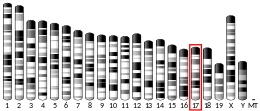Somatostatin receptor 5
Somatostatin receptor type 5 is a protein that in humans is encoded by the SSTR5 gene.[5]
Somatostatin acts at many sites to inhibit the release of many hormones and other secretory proteins. The biological effects of somatostatin are probably mediated by a family of G protein-coupled receptors that are expressed in a tissue-specific manner. SSTR5 is a member of the superfamily of receptors having seven transmembrane segments.[6]
See also
References
- GRCh38: Ensembl release 89: ENSG00000162009 - Ensembl, May 2017
- GRCm38: Ensembl release 89: ENSMUSG00000050824 - Ensembl, May 2017
- "Human PubMed Reference:". National Center for Biotechnology Information, U.S. National Library of Medicine.
- "Mouse PubMed Reference:". National Center for Biotechnology Information, U.S. National Library of Medicine.
- Takeda J, Fernald AA, Yamagata K, Le Beau MM, Bell GI (Aug 1995). "Localization of human somatostatin receptor 5 gene (SSTR5) to chromosome band 16p13.3 by fluorescence in situ hybridization". Genomics. 26 (3): 638–9. doi:10.1016/0888-7543(95)80195-R. PMID 7607700.
- "Entrez Gene: SSTR5 somatostatin receptor 5".
Further reading
- Yamada Y, Post SR, Wang K, et al. (1992). "Cloning and functional characterization of a family of human and mouse somatostatin receptors expressed in brain, gastrointestinal tract, and kidney". Proc. Natl. Acad. Sci. U.S.A. 89 (1): 251–5. doi:10.1073/pnas.89.1.251. PMC 48214. PMID 1346068.
- Montminy MR, Goodman RH, Horovitch SJ, Habener JF (1984). "Primary structure of the gene encoding rat preprosomatostatin". Proc. Natl. Acad. Sci. U.S.A. 81 (11): 3337–40. doi:10.1073/pnas.81.11.3337. PMC 345502. PMID 6145156.
- Panetta R, Greenwood MT, Warszynska A, et al. (1994). "Molecular cloning, functional characterization, and chromosomal localization of a human somatostatin receptor (somatostatin receptor type 5) with preferential affinity for somatostatin-28". Mol. Pharmacol. 45 (3): 417–27. PMID 7908405.
- O'Carroll AM, Raynor K, Lolait SJ, Reisine T (1994). "Characterization of cloned human somatostatin receptor SSTR5". Mol. Pharmacol. 46 (2): 291–8. PMID 8078491.
- Yamada Y, Kagimoto S, Kubota A, et al. (1993). "Cloning, functional expression and pharmacological characterization of a fourth (hSSTR4) and a fifth (hSSTR5) human somatostatin receptor subtype". Biochem. Biophys. Res. Commun. 195 (2): 844–52. doi:10.1006/bbrc.1993.2122. PMID 8373420.
- Yamada Y, Stoffel M, Espinosa R, et al. (1993). "Human somatostatin receptor genes: localization to human chromosomes 14, 17, and 22 and identification of simple tandem repeat polymorphisms". Genomics. 15 (2): 449–52. doi:10.1006/geno.1993.1088. PMID 8449518.
- Fukusumi S, Kitada C, Takekawa S, et al. (1997). "Identification and characterization of a novel human cortistatin-like peptide". Biochem. Biophys. Res. Commun. 232 (1): 157–63. doi:10.1006/bbrc.1997.6252. PMID 9125122.
- Ain KB, Taylor KD, Tofiq S, Venkataraman G (1997). "Somatostatin receptor subtype expression in human thyroid and thyroid carcinoma cell lines". J. Clin. Endocrinol. Metab. 82 (6): 1857–62. doi:10.1210/jc.82.6.1857. PMID 9177396.
- de Lecea L, Ruiz-Lozano P, Danielson PE, et al. (1997). "Cloning, mRNA expression, and chromosomal mapping of mouse and human preprocortistatin". Genomics. 42 (3): 499–506. doi:10.1006/geno.1997.4763. PMID 9205124.
- Jaïs P, Terris B, Ruszniewski P, et al. (1997). "Somatostatin receptor subtype gene expression in human endocrine gastroentero-pancreatic tumours". Eur. J. Clin. Invest. 27 (8): 639–44. doi:10.1046/j.1365-2362.1997.1740719.x. PMID 9279525.
- Hukovic N, Panetta R, Kumar U, et al. (1998). "The cytoplasmic tail of the human somatostatin receptor type 5 is crucial for interaction with adenylyl cyclase and in mediating desensitization and internalization". J. Biol. Chem. 273 (33): 21416–22. doi:10.1074/jbc.273.33.21416. PMID 9694905.
- Sharma K, Patel YC, Srikant CB (1999). "C-terminal region of human somatostatin receptor 5 is required for induction of Rb and G1 cell cycle arrest". Mol. Endocrinol. 13 (1): 82–90. doi:10.1210/me.13.1.82. PMID 9892014.
- Kumar U, Sasi R, Suresh S, et al. (1999). "Subtype-selective expression of the five somatostatin receptors (hSSTR1-5) in human pancreatic islet cells: a quantitative double-label immunohistochemical analysis". Diabetes. 48 (1): 77–85. doi:10.2337/diabetes.48.1.77. PMID 9892225.
- Rocheville M, Lange DC, Kumar U, et al. (2000). "Subtypes of the somatostatin receptor assemble as functional homo- and heterodimers". J. Biol. Chem. 275 (11): 7862–9. doi:10.1074/jbc.275.11.7862. PMID 10713101.
- Rocheville M, Lange DC, Kumar U, et al. (2000). "Receptors for dopamine and somatostatin: formation of hetero-oligomers with enhanced functional activity". Science. 288 (5463): 154–7. doi:10.1126/science.288.5463.154. PMID 10753124.
- Daniels RJ, Peden JF, Lloyd C, et al. (2001). "Sequence, structure and pathology of the fully annotated terminal 2 Mb of the short arm of human chromosome 16". Hum. Mol. Genet. 10 (4): 339–52. doi:10.1093/hmg/10.4.339. PMID 11157797.
- Ballarè E, Persani L, Lania AG, et al. (2001). "Mutation of somatostatin receptor type 5 in an acromegalic patient resistant to somatostatin analog treatment". J. Clin. Endocrinol. Metab. 86 (8): 3809–14. doi:10.1210/jc.86.8.3809. PMID 11502816.
- Pasquali D, Notaro A, Esposito D, et al. (2002). "[Somatostatin receptor genes expression and effects of octreotide on orbital fibroblasts from Graves' ophthalmopathy]". Minerva Endocrinol. 26 (3): 175–9. PMID 11753241.
- Papotti M, Bongiovanni M, Volante M, et al. (2002). "Expression of somatostatin receptor types 1-5 in 81 cases of gastrointestinal and pancreatic endocrine tumors. A correlative immunohistochemical and reverse-transcriptase polymerase chain reaction analysis". Virchows Arch. 440 (5): 461–75. doi:10.1007/s00428-002-0609-x. PMID 12021920.
External links
- "Somatostatin Receptors: sst5". IUPHAR Database of Receptors and Ion Channels. International Union of Basic and Clinical Pharmacology.
- somatostatin+receptor+5 at the US National Library of Medicine Medical Subject Headings (MeSH)
This article incorporates text from the United States National Library of Medicine, which is in the public domain.
This article is issued from Wikipedia. The text is licensed under Creative Commons - Attribution - Sharealike. Additional terms may apply for the media files.




